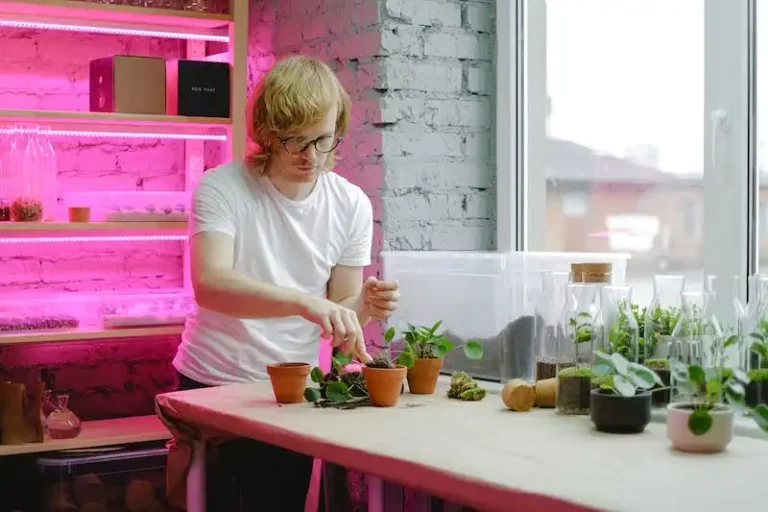The Okra plant, also known as Abelmoschus esculentus, is a flowering plant from the Malvaceae family, which includes hibiscus and cotton. This fast-growing plant is widely cultivated for its edible green pods and is native to regions in Asia and Africa. Okra is an important ingredient in many dishes and is highly valued for its mucilaginous properties, which add thickness and texture to stews and soups. According to WebMD, Okra has been used medicinally for centuries to treat ailments such as diabetes, asthma, and even infertility.
The optimum temperature for growing Okra is between 75 and 90 degrees Fahrenheit. It grows best in well-drained soil and requires frequent watering, especially during hot and dry periods. Okra plants can reach a height of 3 to 6 feet and have large, lobed leaves with spines along the stems and bumps on the fruit. Harvesting can begin as early as 50 days after planting, with most plants yielding pods within 2 months.
When harvesting Okra, it is best to wear gloves as the plant can cause skin irritation due to its tiny spines. To conserve moisture, the plants should be watered deeply and regularly, especially during dry spells. Okra can be stored for a few days in the refrigerator, but should always be used as fresh as possible for the best taste and flavor. The plant can also be preserved by freezing or canning.
One variety of Okra, called “Clemson Spineless,” is especially popular in the United States, where it is cultivated in states like Illinois and South Carolina. Okra plants are often grown in backyard gardens due to their ease and effort in growing. They are typically planted in rows with spacing of 12 to 18 inches between plants and 3 to 4 feet between rows. Pruning the plant can help promote better airflow and prevent diseases, such as fungal infections and nematode infestation.
Despite its popularity as a vegetable, Okra plants are prone to pests and diseases. Common pests that may infest Okra plants include aphids, flea beetles, and whiteflies. Diseases like powdery mildew and root rot can also affect the plant’s health. Regular inspections and proper care can help prevent and treat these issues. In some cases, pesticide applications may be necessary. It is important to follow the instructions on the pesticide label and apply them with caution.
In conclusion, the Okra plant is a versatile and nutritious vegetable that can be grown in various climates. Its fast growth, high yield, and culinary uses make it a popular choice for home gardeners and commercial farmers alike. Whether used fresh or cooked, Okra adds a unique taste and texture to a variety of dishes. With proper care and attention, Okra plants will thrive and provide a bountiful harvest.
How to Grow and Care for Okra
Growing and caring for okra can be a rewarding experience for any gardener, especially those in warm climates. Okra, also known as gumbo, is a vegetable that thrives in hot summers and tropical climates. It is a member of the mallow family and is a popular ingredient in dishes like gumbo and khara.
Here are some tips on how to grow and care for okra:
| Attributes | Instructions |
|---|---|
| Soil | Okra grows well in full sun and in neutral to slightly acidic soil. Prepare the soil by turning it over and removing any weeds or debris. |
| Planting | Plant okra seeds in early spring, after the last frost date. Dig a hole and plant the seeds about half an inch deep. Space the seeds at least 12 to 18 inches apart. |
| Watering | Water newly planted okra seeds regularly to keep the soil moist. Once the plants are established, water deeply once a week. Avoid overwatering to prevent diseases. |
| Fertilizing | Fertilize okra plants with a balanced fertilizer about a month after planting. Apply the fertilizer according to the package instructions. |
| Companion Planting | Okra can be planted alongside other vegetables like tomatoes and peppers. This can help deter pests and improve the overall productivity of your garden. |
| Pests and Diseases | Okra is generally resistant to most pests and diseases. However, be on the lookout for pests like aphids, beetles, and nematodes. If necessary, use organic insecticidal soap to control these pests. |
| Harvesting | Harvest okra pods when they are about 2-3 inches long. Use a sharp knife or scissors to cut the pods from the stems. Harvesting should be done every 2-3 days to ensure continuous production. |
| Propagation | If you want to grow okra again the following year, save some of the pods and leave them to dry out. Once dry, remove the seeds and store them in a cool, dry place until the next planting season. |
By following these care instructions, you can enjoy a bountiful harvest of tasty okra from your backyard garden. Always read updated information and do proper fact-checking for specific regional or public growing guidelines, especially if you are a new gardener or live in a coastal or late-fall planting area.
How to Plant Okra
Okra is a well-draining, heat-loving plant that belongs to the hibiscus family. It is best suited for growing in warm climates, such as Oklahoma and the Carolinas, where it can be planted directly in the ground.
Before planting, select a variety of okra that is disease-resistant and can thrive in your specific region. Okra can be grown from either seeds or transplants. If starting from seeds, plant them about 1 inch deep and space them about 12-18 inches apart. Transplants should be spaced 18-24 inches apart in rows that are about 3 feet apart.
Okra prefers full sun exposure and well-drained soil. It is a relatively low-maintenance plant, but it does require regular watering, especially during dry periods. Be careful not to overwater, as this can lead to root rot and other diseases. To conserve water and reduce weed growth, apply a layer of mulch around the base of the plants.
Okra plants can grow tall and upright, so providing support, such as stakes or trellises, may be needed to prevent them from falling over. Heavy winds can also cause damage to the plants, so additional support may be necessary in areas with high wind exposure.
After planting, it usually takes about 55-60 days for okra plants to start producing pods. Harvesting should be done when the pods are about 2-4 inches long and still tender. Harvesting regularly encourages more pod production. Be careful when handling the pods, as they may have tiny spines that can cause skin irritation.
When harvesting okra, it is best to use a sharp knife or scissors to cut the pods from the stem. Avoid pulling or twisting the pods, as this can harm the plant. Harvesting should be done in the morning when the pods are still cool and the spines are less prickly. Check the plants daily, as the pods can mature rapidly.
Okra is a popular ingredient in many dishes, such as gumbo, and is known for its slimy texture when cooked. If you find the sliminess unpleasant, there are several cooking techniques, such as frying or roasting, that can help reduce it.
It’s always a good idea to do some fact-checking and consult reliable sources for more specific information on growing okra. Experienced gardeners and local agricultural extension offices can provide valuable insights and guidance tailored to your area.
When to Plant
Okra is a popular warm-season vegetable plant in many parts of the world. The ideal time for planting depends on your location and climate. In general, okra should be planted after the last frost date in your area when the soil has warmed up enough. In the northern hemisphere, this usually means planting in late spring or early summer.
If you live in a region with a short growing season, you may want to start your okra seeds indoors several weeks before the last frost date. This will give the plants a head start and allow them to grow larger before being transplanted to the garden. Alternatively, you can choose a faster-maturing variety or use containers for growing okra, which can be moved indoors if needed.
Okra plants require a sunny site with well-drained soil. Before planting, prepare the site by loosening the soil and incorporating organic matter to improve moisture retention. A soil test can help you determine if any additional amendments, such as fertilizer or lime, are needed.
Okra plants can reach up to 6 feet (2 meters) in height, so they may need support to keep the stems upright. This can be achieved by using stakes or a trellis system. Providing support will also help reduce the risk of damage from strong winds or heavy rain.
When it comes to pest control, okra plants can be subject to various problems such as nematodes, aphids, and other pests. To reduce the risk of infestation, practice good hygiene by removing plant debris and weeds from the area around the plants. In addition, using natural ingredients such as soap spray can help control pests. If necessary, there are also chemical pesticides available for use, but be sure to follow the instructions carefully.
Okra plants are typically heavy fruit producers, with cultivars such as Clemson Spineless being a popular variety. The fruit is harvested when it is young and tender, usually about 2 to 3 inches (5 to 7.5 centimeters) long. Harvesting should be done regularly to prevent the pods from becoming too tough and fibrous.
In cooler regions, where overnight temperatures can drop below freezing, okra plants will not survive the winter. However, if you live in a milder climate, such as Oklahoma, you may be able to overwinter your plants with some care. This involves cutting the plants back and leaving a short stub above the ground. Mulching around the base of the plant can also help protect the roots from freezing temperatures.
In summary, the best time to plant okra is after the last frost date in your area when the soil has warmed up. Providing a sunny site with well-drained soil, giving support to the growing plants, and addressing any pest issues are important for successful okra plantings. Regular harvesting and overwintering practices, if applicable to your climate, can also help you enjoy a bountiful okra harvest.

